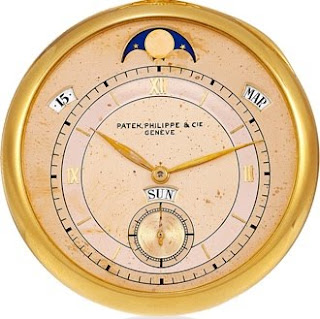Calendars are part of math.
They help us count and organize what happens on certain days.
In today's blog we ask:
How can we express calendar events with a watch or clock?
(Day of the week, date in the month, month of the year and phase of the moon)
They help us count and organize what happens on certain days.
In today's blog we ask:
How can we express calendar events with a watch or clock?
(Day of the week, date in the month, month of the year and phase of the moon)
It seems there are two very popular displays: hands on dials or words in windows.
Here's an old and very expensive Patek watch that uses the words in windows approach.
There's a number for the date, then words for day and month (and moon phase at the top).
This IWC watch shows the calendar using yellow hands on dials.
There's a number for the date, then words for day and month (and moon phase at the top).
This IWC watch shows the calendar using yellow hands on dials.
It has day of the week, month, and date on 3 sub-dials.
The moon is at top center, and the year in a small window at bottom left.
The moon is at top center, and the year in a small window at bottom left.
Here's another IWC watch, but it uses numbers in windows for month and day.
A tiny L indicator in the bottom window tells us if it's a leap year.
For Americans, this layout isn't ideal, as we tend to put the month first (08 / 25 / 2010)
rather than having the day of the month first like most of the world ( 25 / 08 / 2010 ).
An advantage is the watchmaker doesn't need to print dials in different languages.
An advantage is the watchmaker doesn't need to print dials in different languages.
This gold Girard-Perregaux watch clearly expresses the day, month, date and moon phase.
Windows and words display the day and month, while a hand on dial is used for the date.
Here's another watch with windows and words for the day and month.
In this case the date is around the outer edge of the dial so the numbers can be larger.
This one uses the opposite approach, a window for the date (at top),
and at the bottom, dials display the day on the left, and month at the right.
The center dial indicates a second time zone on a 24-hour scale.
Here's an unusual piece just shown this year,
with fully-spelled-out month and day, on rolling word in window indicators.

The following clock uses neither words in windows or hands on dials.
Little black and red tabs move in the background, highlighting a specific day and date.
That way all the motion is created with a rotary clock motor, no flipping, rolling words here!
This is a creative design and used by some watches too. We'll call it back-lit indication, okay?
This Seiko clock cost about $75 but has been discontinued.
This is a creative design and used by some watches too. We'll call it back-lit indication, okay?
This Seiko clock cost about $75 but has been discontinued.

Now that we have discovered this 3rd method of indication,
we're in the position to say Just because you can do it doesn't make it better!
The photos here show two new and different JLC calendar watches.
They show the same calendar features, but which is easier to read?
Hands on dials are better than back-lit indicators, in my estimation!
Granted, with the watch on the right you get to see the movement too, but it's very hard to read.
In case this blog has you wanting a clock calendar on your desk,
here is is a new, easy-to-read, hands on dials,
Chelsea clock you can buy today for $350.

Or do you prefer the words in windows calendar display?
It isn't a new idea. Here's an Ithaca
clock calendar mechanism that was patented 150 years ago!
It isn't a new idea. Here's an Ithaca
clock calendar mechanism that was patented 150 years ago!
This is how it looks in a complete Ithaca clock.
We see words in windows for day and month.
The date is shown with hand on dial around the the outside of the dial.
It's almost exactly like the older JLC watch shown earlier.
The time is on a separate upper section.
This clock is 145 years old and in beautiful shape.
Finally, here's a Dussalt clock with the months around the outside of the dial.
This is a real antique work of art.
I'll keep looking, and I will let you know if I find any other method besides
words in windows, hands on dials, and back-lit indicators.











No comments:
Post a Comment
Type your comment here